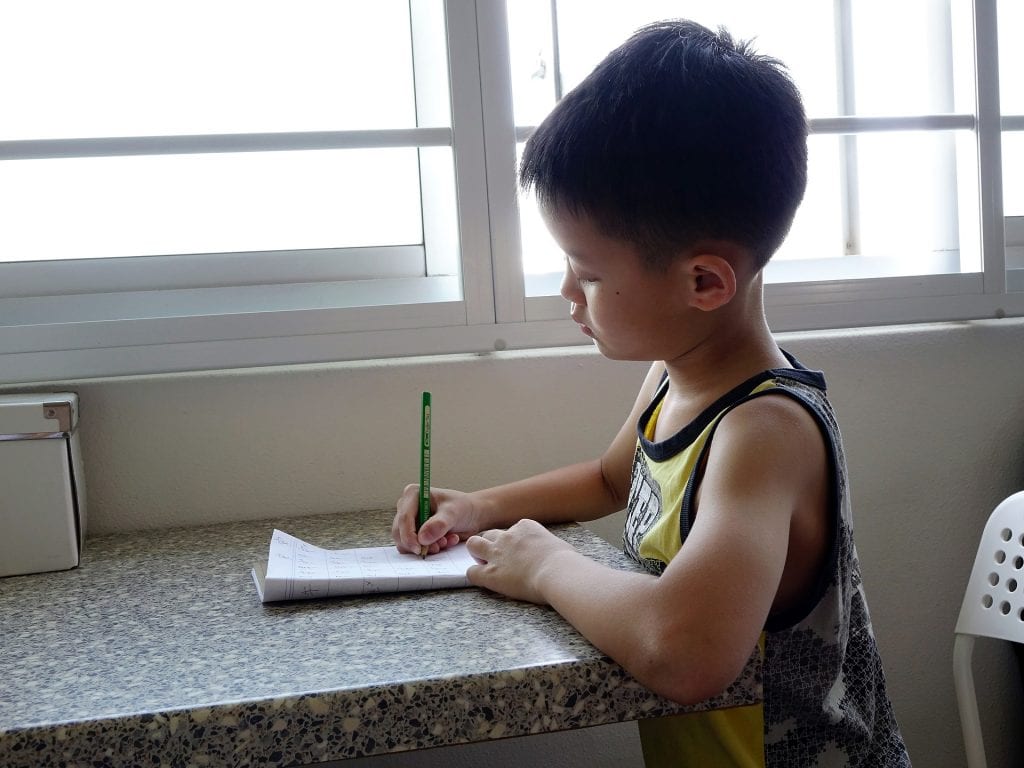
We’re all looking for ways to lure our kids away from their screens for a couple of hours. Why not ignite their imaginations through the wonderful world of stories? No, I don’t mean stories in the form of movies or video games. I’m talking about the old-fashioned written word.
These five writing exercises, or “prompts” as they’re often called, have all been extremely useful in getting me through my moments of writer’s block over the years, but you don’t need to be an author to have fun with them! Not only are they super fun, they’re also a good tool to exercise your child’s mind. I like to think that the mind is a muscle, and if it isn’t regularly exercised, it becomes weak. This is true for adults, too, so parents: feel free to join in the fun!
1) Three Random Words: I’m starting with my personal favorite. It is exactly as it sounds: you pick three random words (the more random, the better) and then you write a story where you must somehow include those three words. Find the words anywhere you want. Sometimes it’s fun if you come up with them by looking around the room and picking out three random objects or adjectives that you see. The story can be about anything, and it can be as long or as short as you like. The only rule is that you need to include your three random words before you finish.
I once wrote a “Three Random Words” story where my words were blueberry, cat and lighthouse. I ended up with a story about a little girl and her pet cat who baked the most delicious blueberry muffins in town, until one day the cat wanders off to the mysterious lighthouse up the road and the little girl ends up giving the lighthouse keeper a year’s supply of muffins so that he’ll return the cat. (I told you—the more random, the better!)

2) Finish the Thought: This one requires a little more imagination on the writer’s part (and another person who is willing to humor them). It works like this: You ask someone to give you a sentence. Any sentence will do. “The dog jumped over the fence into the neighbor’s yard.” “Billy walked down the path for hours, but he couldn’t find anything.” It doesn’t matter what it is. What matters is how you finish it.
Your job, once you have your sentence, is to use that sentence as the very first line in a story, and then write the rest of the story. Again, it doesn’t matter how long or short the story is, or what it ends up being about. As long as you keep in mind whatever sentence you were given and write a story that can be traced back to it, you’re golden.
3) One Sentence at a Time: I love this one, but it does require two or more people to do. It’s a great one to do with your child, or even as a whole family. Each participant takes turns writing the same story, one sentence at a time. Person A will start the story with a sentence, then pass the pen and paper along to Person B, who will read what Person A wrote and then write the next sentence – and so on. If you want an extra challenge, you can make it “one word at a time.” The story ends whenever someone decides to end it, which, in my experience, has always been many pages into the story.
This exercise creates some of the funniest outcomes because participants end up trying to “one up” each other with content and amusement (especially if the participants are children). These stories are also a great keepsake because – take it from me – they are absolutely hilarious to find in an old box years later and read aloud.

4) The Rainbow Connection: No, not the song. For this exercise, you take the first letters of each color in the rainbow: ROY G BIV, if you will. With these letters, you’re going to create a very short story – seven sentences to be exact (fragment sentences are acceptable here). Each sentence must start with a word that begins with one of those rainbow letters, and you can’t use any of the letters twice!
It doesn’t matter what order you put them in. Or what you write about. But you must use all the letters. Really, it isn’t that complicated. You’ll be surprised how easy it is once you start. Given that you and your kids are a bunch of smart cookies, you’ll probably find this exercise enjoyable. Very enjoyable.
(Look closer at that last paragraph. I just gave you an example of this exercise!)

5) The Animal Diaries: Imagine you’re an animal. Any animal. Your task is to write a diary entry of a day in your life as that animal. Here’s the catch: you don’t live in a jungle or a swamp or a farm, or wherever your animal might live. Nothing else about your life is any different. So, you still wake up in your bed, eat breakfast in your kitchen, go to school/work, etc. You’re just living your life as an animal. What would it be like? How would it be harder (or easier) for you to do things? What would people say?
The possibilities are endless here, because these diary entries can be written over and over again each time you choose to “become” a different animal. My favorite one of these that I ever wrote was when I woke up as an unidentified flying insect. Until I wrote that “diary entry,” I never realized how insects must feel to constantly be swatted at all day long. I still swat at any flying bug who won’t leave me alone, but I’m much more empathetic toward them!
C.A. Klug is a 29-year-old children’s author who has been writing since the age of 5. Her debut novel, “The Sought Six: The Sterling Cone,” is an Amazon bestseller and already a beloved read-aloud book in fifth and sixth grade classrooms. Follow her on Instagram, Facebook and Twitter.

































